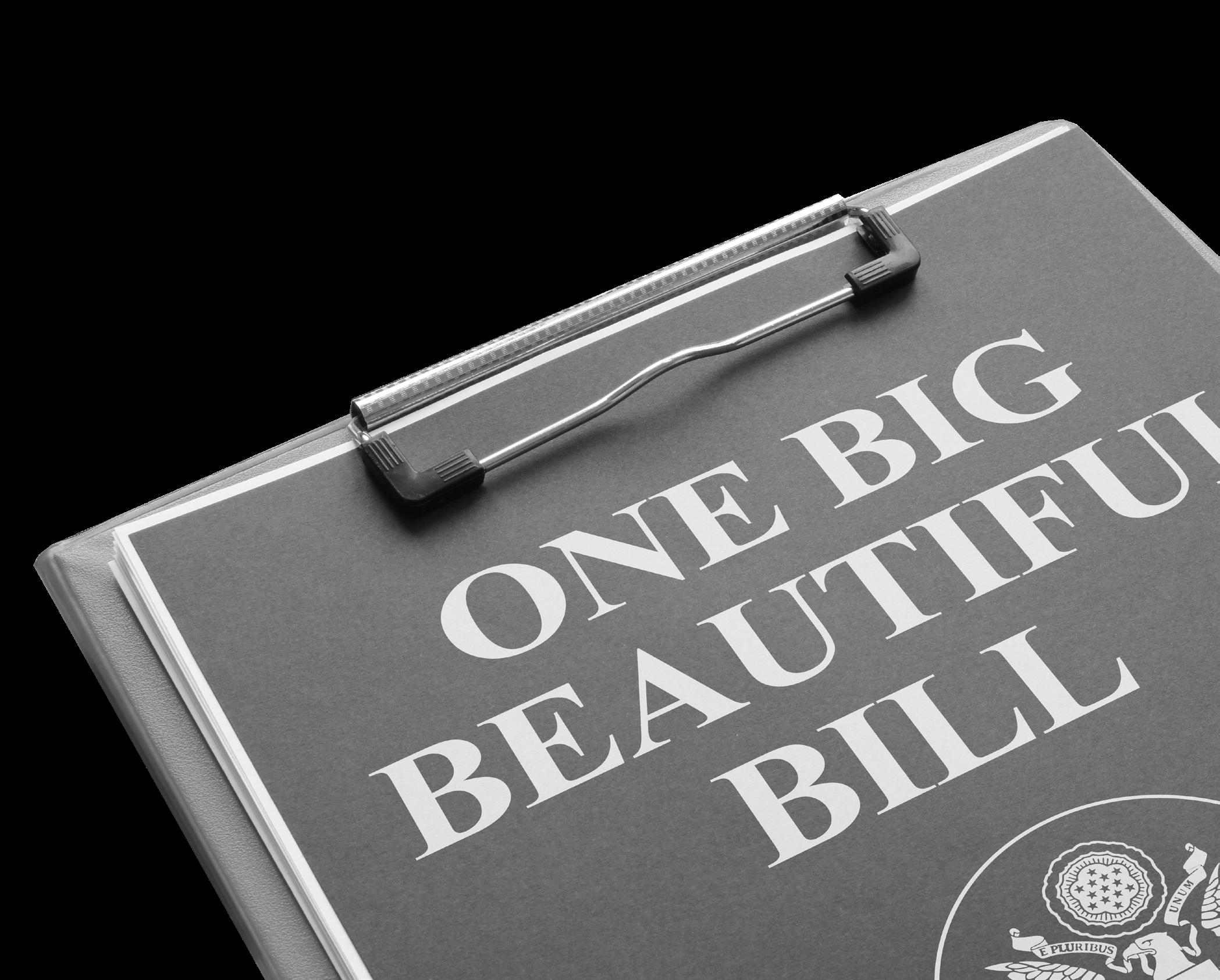H.R. 1: ONE BIG BEAUTIFUL BILL ACT VOTER
Impact on Black Communities


On July 4, 2025, President Donald Trump signed H.R. 1, the Republicans’ massive tax and immigration package, into law. The bill, known as the One Big Beautiful Bill Act, passed the House on July 3, by a 218–214 vote. Two days earlier, it cleared the Senate by a 51–50 vote, with Vice President J.D. Vance casting the tie-breaking vote. Three Republicans, Thom Tillis (NC), Susan Collins (ME), and Rand Paul (KY), broke with their party and joined Democrats to oppose the legislation. The House version of the bill had passed weeks earlier, on May 22, by a narrow 215–214–1 margin with no Democratic support.
Hailed by President Trump as “a big, beautiful bill,” the legislation is a sweeping compilation of conservative fiscal and policy priorities that will add $5 trillion to the nation’s debt limit while significantly rolling back federal investments in health care, food assistance, climate, criminal justice, and civil rights enforcement. Although some elements, like the modest expansion of the Child Tax Credit (CTC), one-time savings accounts for newborns, and the elimination of income taxes on tips and overtime wages, have garnered limited bipartisan support, the overall package has sparked concern among civil rights leaders, economic justice advocates, and members of the Congressional Black Caucus. Ultimately, the legislation is poised to reshape federal investments in health care, social supports, and clean energy, with disproportionate impacts on Black communities across the country.

What This Means for Black Communities
1 | RISK ING HEALTH EQUITY
The bill’s over $1 trillion in cuts to Medicaid will dramatically increase the number of uninsured Black Americans. These cuts are estimated to lead to higher premiums and out-of-pocket costs for those with employer-sponsored coverage, including many working-class Black families. The bill’s Medicaid work requirements are projected to disproportionately harm older Black adults, family caregivers, and people with disabilities—groups that often face systemic barriers to consistent employment. By making health care less accessible and more expensive across multiple coverage types, the bill will deepen existing disparities in health outcomes and further destabilize community health systems already operating under conditions of historic disinvestment.
2 | UNDERMINING ECONOMIC SUPPORTS
While the bill includes a modest expansion of the CTC for families with moderate and high incomes, and a new tax deduction for tipped workers that could benefit some Black service workers, it makes deep cuts to core economic supports like the Supplemental Nutrition Assistance Program (SNAP) and affordable housing assistance. SNAP is one of the most effective anti-poverty tools available, with nearly one in five children relying on it for daily nutrition. These cuts will lead to reduced access to food and worsened health and financial outcomes for Black communities. Further, the bill undercuts economic advancement by slashing funding to the Consumer Financial Protection Bureau (CFPB), a key agency in fighting predatory lending and discriminatory financial practices. The CFPB plays a vital role in ensuring Black consumers are protected from the kinds of economic exploitation that have long undermined wealth-building in Black communities.
3 | ERODING EDUCATION ACCESS
The bill will undermine educational opportunities for millions of Black students by reducing financial aid, weakening borrower protections, and diverting public funds to private schools. Changes to eligibility requirements for Pell Grants, the rollback of income-driven repayment plans, and new limits on student loans will force many low- and middle-income Black students to take on more debt or forgo higher education altogether. These changes may also saddle Black borrowers with unaffordable debt for decades and deny relief to those impacted by predatory institutions. In K-12 education, the bill includes tax-credit vouchers which redirect federal funds away from public schools, on which 90% of students rely. These vouchers will disproportionately impact Black students who depend on public education and exacerbate existing inequities in school funding, quality, and access.
4 | ROLLING BACK ENVIRONMENTAL JUSTICE
The bill’s rollback of clean energy investments and energy efficiency programs threatens to deepen environmental and economic inequality. At a time when energy bills are expected to rise due to increased fuel prices and extreme weather, the bill eliminates federal programs that help reduce household energy burdens through weatherization and efficiency upgrades. These cuts will hit Black households particularly hard, as they are more likely to live in older, less energy efficient housing and already spend a disproportionate share of income on utility bills. Repealing clean energy incentives also stifles job creation in renewable sectors, limiting economic opportunities for Black workers in communities transitioning from fossil fuel economies. Altogether, the bill will worsen pollution exposure, financial strain, and climate vulnerability in already overburdened communities.
5 | REMOVING CIVIL RIGHTS PROTECTIONS
The bill devotes $170 billion to building a mass deportation infrastructure and expanding Immigration and Customs Enforcement’s (ICE) surveillance powers. These investments will accelerate racialized immigration enforcement, targeting Black and Brown immigrants who already face disproportionate rates of detention, deportation, and abuse. The bill also makes changes to the federal government’s largest law enforcement grant program, prohibiting jurisdictions from using funds for community violence prevention programs. These programs have shown promise in reducing crime without relying on over-policing, particularly in Black communities. By restricting how localities can use federal resources, and embedding punitive policies into law, the bill strips communities of tools that support public safety without systemic harm, undermining both racial justice and local autonomy. Collectively, these provisions roll back decades of civil rights progress and open the door to deeper inequities for marginalized communities.
Key Features & Community Impacts
CHILD TAX CREDIT (CTC)
Modestly expands the CTC from $2,000 to $2,200 for families with moderate and high incomes; excludes 17 million children from the full credit amount because their families’ incomes are too low.
IMPACT FOR BLACK COMMUNITIES
Excludes the lowest-income Black children.
RESOURCES
Will the reconciliation bill’s Child Tax Credit changes leave out children in low-income working families?
Brookings Institute
“One Big Beautiful Bill” Child Tax Credit Would Exclude Millions of American Children
—Tax Policy Center
What’s in the 2025 Republican Tax Law
—Bipartisan Policy Center
CRIMINAL JUSTICE
Prohibits jurisdictions from using federal funds for community violence prevention programs.
IMPACT FOR BLACK COMMUNITIES
Eliminates funding for evidence-based programs that improve public safety without over-policing Black communities.
RESOURCES
How the “Big Beautiful Bill” Will Change Criminal Justice and Immigration
The Marshall Project
The Trump Administration’s Budget Will Undermine ATF’s Efforts To Prevent Violent Crime Center for American Progress
CLEAN ENERGY & CLIMATE
Cuts renewable energy programs and job-creating investments; eliminates hundreds of thousands of green jobs; withdraws the $7,500 electric vehicle tax credit; phases out tax breaks for solar, wind, and geothermal energy.
IMPACT FOR BLACK COMMUNITIES
Reverses environmental justice gains; heightens energy costs and pollution in Black neighborhoods.
RESOURCES
The One Big, Beautiful Bill Act Endangers the Transformation of Contaminated Sites for Clean Energy Production
—Center for American Progress
Updated: Economic Impacts Of U.S. “One Big Beautiful Bill Act” Energy Provisions
—Energy Innovation Policy & Technology
What Trump’s Anti-Environment One Big Beautiful Bill Act Means for Your Wallet, Health, and Safety Center for American Progress

ECONOMIC POLICY
Extends 2017 tax cuts for wealthiest 1%; increases the estate tax exemption; revises corporate tax breaks; adds tax deductions for tipped workers and overtime; $1000 tax-advantaged savings accounts for children born between 2025 and 2028; changes tax policy to increase utility costs; $5 trillion expected to be added to the national debt.
IMPACT FOR BLACK COMMUNITIES
Tip deductions could benefit Black service workers by potentially reducing their taxable income but generally benefit businesses; one-time savings account for newborns may provide modest benefits to some Black families; overall directs tax benefits to the wealthy; erodes public revenue and services; heightens financial strain on Black families and widens financial inequity.
RESOURCES
Analysis of Tax Provisions in the Trump Megabill as Signed into Law: National and State Level Estimates ITEP
Don’t Be Fooled, GOP Tax Plan Is Bad for Working People and Families —Demos
What Will The Tax Provisions Of The Big Budget Bill Really Do? —Tax Policy Center
EDUCATION & VOUCHERS
Creates private school voucher tax subsidies.
IMPACT FOR BLACK COMMUNITIES
Undermines public schools that serve Black students; directs public funds away without equity safeguards.
RESOURCES
Megabill Takes Cap Off Unprecedented Private School Voucher Tax Credit, Potentially Raising Cost by Tens of Billions Relative to Earlier Version —ITEP
10 Egregious Things You May Not Know About the One Big Beautiful Bill Act Center for American Progress
HOUSING & FAIR LENDING
Reduces fair housing enforcement; weakens small-business lending data; cuts housing vouchers and fair housing enforcement; creates deep cuts to the Consumer Financial Protection Bureau, which helps fight predatory lending and discriminatory financial practices; no new affordable housing investments.
IMPACT FOR BLACK COMMUNITIES
Exacerbates the housing crisis; deepens segregation; increases lending discrimination; restricts Black business access to capital.
RESOURCES
2025 Reconciliation Debate: Housing Provisions —Bipartisan Policy Center House Republican Reconciliation Bill Would Harm Rural Households, Communities, and Economies —Center on Budget and Policy Priorities
How did the One Big Beautiful Bill Act change Opportunity Zones? —Brookings Institution

IMMIGRATION & DETENTION
Adds $45 billion in funding for expanded immigration detention facilities and deportation operations; remittance taxes; new fees and barriers to familybased immigration.
IMPACT FOR BLACK COMMUNITIES
Creates fear and instability in Black immigrant communities; penalizes cross-border support; reduces economic supports sent to families abroad.
RESOURCES
The Anti-Immigrant Policies in Trump’s Final “Big Beautiful Bill,” Explained National Immigration Law Center
One Big Beautiful Bill Act: Immigration Provisions
—National Immigration Forum
What’s in the 2025 Reconciliation Bill So Far?
—American Immigration Council
MEDICAID & HEALTH
Issues more than $1 trillion in cuts to Medicaid, which provides health coverage to over 70 million people; adds stricter eligibility requirements, including proof of work or disability requirement for low-income childless adults under 65; Affordable Care Act reductions; withdraws funding for Planned Parenthood; projected 11.8 million uninsured by 2034.
IMPACT FOR BLACK COMMUNITIES
Reverses health equity gains; higher uninsured rates; harms children, seniors, disabled, rural and urban Black communities; worsens health outcomes in Black populations.
RESOURCES
The Truth About the One Big Beautiful Bill Act’s Cuts to Medicaid and Medicare —Center for American Progress
Tax Cuts Now, Benefit Cuts Later: The Timeline in the Republican Megabill —New York Times
New CBO estimates show 2025 reconciliation bill would have impacts similar in magnitude to 2017 ACA repeal bills —Brookings Institution
PHILANTHROPY
Reduces incentives for charitable giving by increasing thresholds.
IMPACT FOR BLACK COMMUNITIES
Shrinks donations to nonprofits and HBCUs; threatens funding for Black-led civic organizations.
RESOURCES
One Big, Beautiful Bill complicates charitable giving —Brookings Institution
One, Big, Beautiful Bill: Impact on Philanthropy —Council on Foundations
SUPPLEMENTAL NUTRITION
ASSISTANCE PROGRAM (SNAP)
Reduces federal funding for SNAP to lowincome households and adds eligibility restrictions and work requirements; shifts administrative costs to states; up to 11 million people could lose full or partial benefits.
IMPACT FOR BLACK COMMUNITIES
Increases food insecurity and poverty disproportionately affecting Black children and households.

STUDENT AID & BORROWERS
Cuts financial aid; weakens borrower protections; eliminates Grad PLUS loans; increases credits required for Pell Grant eligibility; diverts public funds to private schools.
IMPACT FOR BLACK COMMUNITIES
Forces more Black students to forego higher education or assume increased debt, slowing upward mobility.
RESOURCES
How Trump’s Spending Bill Will Impact Your Student Loans—As It Heads To President For Signature —Forbes
The Impact of the “One Big Beautiful Bill Act” on Students, Families, and Public Education New America
2025 Budget Reconciliation and Student Loans —Bipartisan Policy Center
What You Can Do
RAISE AWARENESS:
Public polling shows many Americans do not know what is in H.R. 1. Share this resource to educate your networks about the real-world impact of this bill on Black communities and other marginalized groups.
HOLD LAWMAKERS ACCOUNTABLE:
The bill passed with razorthin margins. Make sure your representatives know how you feel about their votes.
Find your elected officials here .
SUPPORT LOCAL RESISTANCE:
As fed eral protections are rolled back, state and local organizing will be essential to defending rights, expanding access to resources, and mitigating harm.
PREPARE FOR THE LONG FIGHT:
This i s not the end. Join coalitions working to restore lost protections, fight future rollbacks, and build a more equitable federal agenda in the years ahead.

CENTER FOR POLICY ANALYSIS AND RESEARCH Voter Empowerment and Black Civic Engagement
